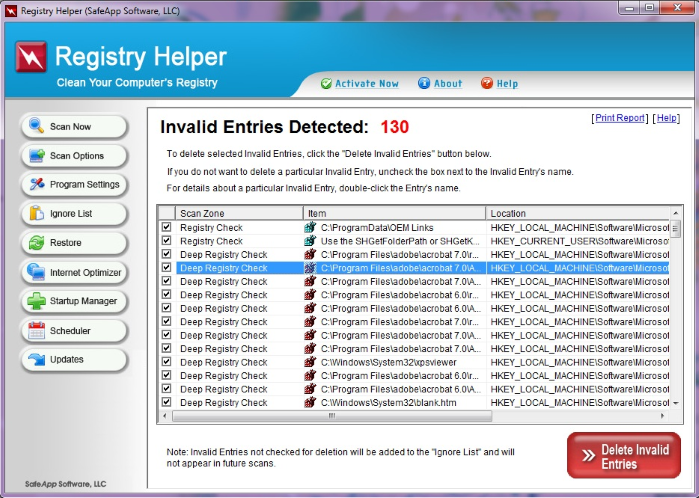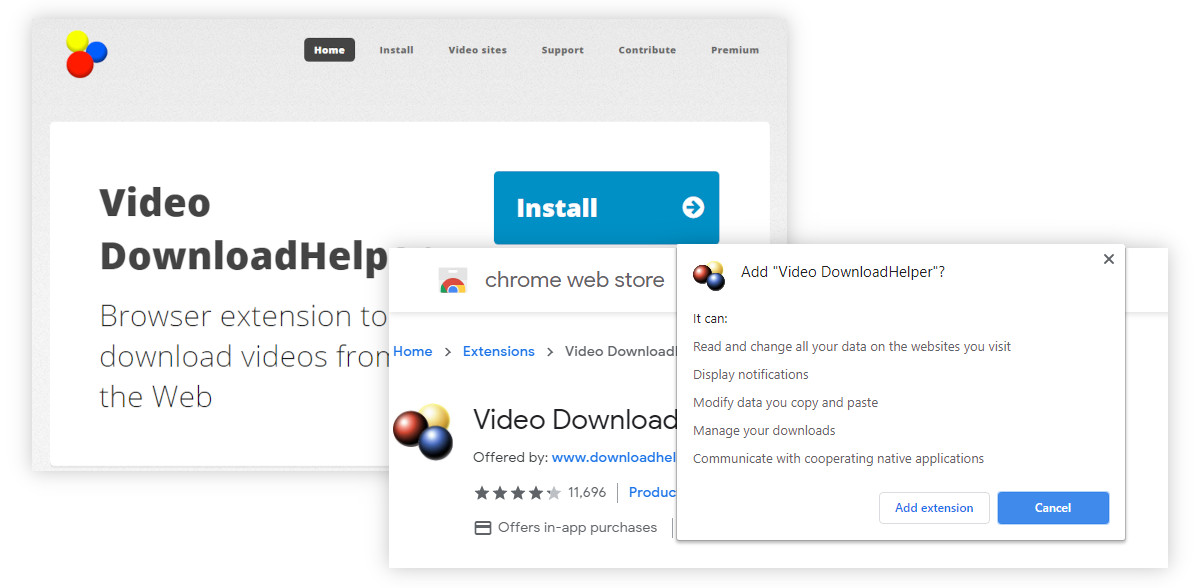That should get rid of both Free File Opener and Registry Helper. Another idea would be to download Revo Uninstaller and use it to uninstall both of those applications. I assume you are willing to get rid of FFO as well as RH? Good idea to run MSE and Malwarebytes. Keep your eyes peeled for odd PC behavior.
- Registry Helper Removal Tool Download Mac
- Best Free Registry Repair Tool
- Pc Tools Registry Mechanic Download
- Registry Helper Removal Tool Download No Survey
- Registry Tools Repair
- Clean Registry Tools
How to Remove RegistryHelper from Your Computer
To completely purge RegistryHelper from your computer, you need to delete the files, folders, Windows registry keys and registry values associated with RegistryHelper. These files, folders and registry elements are respectively listed in the Files, Folders, Registry Keys and Registry Values sections on this page.
Comodo Uninstaller Tool page is a tutorial on how to search find and remove Comodo Internet Security, Firewall, or Antivirus products. Click here to find a guidance about this. Download Registry Help for Windows to clean and repair your registry, speed up your computer, and optimize your system. To remove the RegistryHelper registry keys and values: On the Windows Start menu, click Run.; In the Open box, type regedit and click OK. The Registry Editor window opens. This window consists of two panes. The left pane displays folders that represent the registry keys arranged in hierarchical order. Oct 09, 2020 Download the Norton Remove and Reinstall tool. Save the file to the Windows desktop. On some browsers, the file is automatically saved to its default location. To open the Downloads window in your browser, press the Ctrl + J key. Double-click the NRnR icon. Read the license agreement, and click Agree. Click Remove & Reinstall.
For instructions on deleting the RegistryHelper registry keys and registry values,
see How to Remove RegistryHelper from the Windows Registry.
For instructions on deleting the RegistryHelper files and folders,
see How to Delete RegistryHelper Files (.exe, .dll, etc.)
How to Delete RegistryHelper Files (.exe, .dll, etc.)^
The files and folders associated with RegistryHelper are listed in the Files and Folders sections on this page.
To delete the RegistryHelper files and folders:
- Using your file explorer, browse to each file and folder listed in the Folders and Files sections.
- Select the file or folder and press SHIFT+Delete on the keyboard.
- Click Yes in the confirm deletion dialog box.
[%PROFILE_TEMP%]RegistryHelperSetupAM2.exe
[%DESKTOP%]Registry Helper.lnk
[%PROGRAM_FILES%]Registry Helper
[%PROGRAMS%]Registry Helper

How to Remove RegistryHelper from the Windows Registry^
The Windows registry stores important system information such as system preferences, user settings and installed programs details as well as the information about the applications that are automatically run at start-up. Because of this, spyware, malware and adware often store references to their own files in your Windows registry so that they can automatically launch every time you start up your computer.
To effectively remove RegistryHelper from your Windows registry, you must delete all the registry keys and values associated with RegistryHelper, which are listed in the Registry Keys and Registry Values sections on this page.
To remove the RegistryHelper registry keys and values:
- On the Windows Start menu, click Run.
- In the Open box, type regedit and click OK.
The Registry Editor window opens. This window consists of two panes. The left pane displays folders that represent the registry keys arranged in hierarchical order. The right one lists the registry values of the currently selected registry key. - To delete each registry key listed in the Registry Keys section, do the following:
- Locate the key in the left pane of the Registry Editor window by sequentially expanding the folders according to the path indicated in the Registry Keys section. For example, if the path of a registry key is HKEY_LOCAL_MACHINEsoftwareFolderAFolderBKeyName1sequentially expand the HKEY_LOCAL_MACHINE, software, FolderA and FolderB folders.
- Select the key name indicated at the end of the path (KeyName1 in the example above).
- Right-click the key name and select Delete on the menu.
- Click Yes in the Confirm Key Delete dialog box.
- Locate the key in the left pane of the Registry Editor window by sequentially expanding the folders according to the path indicated in the Registry Keys section. For example, if the path of a registry key is
- To delete each registry value listed in the Registry Values section, do the following:
- Display the value in the right pane of the Registry Editor window by sequentially expanding the folders in the left pane according to the path indicated in the Registry Values section and selecting the specified key name. For example, if the path of a registry value is HKEY_LOCAL_MACHINEsoftwareFolderAFolderBKeyName2,valueC=sequentially expand the HKEY_LOCAL_MACHINE, software, FolderA and FolderB folders and select the KeyName2 key to display the valueC value in the right pane.
- In the right pane, select the value name indicated after a comma at the end of the path (valueC in the example above).
- Right-click the value name and select Delete on the menu.
- Click Yes in the Confirm Value Delete dialog box.
- Display the value in the right pane of the Registry Editor window by sequentially expanding the folders in the left pane according to the path indicated in the Registry Values section and selecting the specified key name. For example, if the path of a registry value is
HKEY_LOCAL_MACHINESYSTEMCurrentControlSetServicesRegistry Helper Service
HKEY_LOCAL_MACHINESOFTWAREMicrosoftWindowsCurrentVersionApp PathsRegistryHelper.exe
[HKEY_CURRENT_USERSOFTWAREMicrosoftWindowsCurrentVersionRun]Registry Helper='[%PROGRAM_FILES%]Registry HelperRegistryHelper.Exe' /boot
[HKEY_LOCAL_MACHINESOFTWAREMicrosoftWindowsCurrentVersionRun]Registry Helper=[%PROGRAM_FILES%]Registry HelperRegistryHelper.exe /boot
[HKEY_CURRENT_USERSOFTWAREMicrosoftWindowsCurrentVersionRun]Registry Helper='[%PROGRAM_FILES%]Registry HelperLaunchRegistryHelper.Exe' '[%PROGRAM_FILES%]Registry HelperRegistryHelper.Exe' /boot
[HKEY_CURRENT_USERSOFTWAREMicrosoftWindowsCurrentVersionRun]Registry Helper='[%PROGRAM_FILES%]Registry HelperRegistryHelper.exe' /cosell
[HKEY_CURRENT_USERSOFTWAREMicrosoftWindowsCurrentVersionRun]Registry Helper=//~[%PROGRAM_FILES%]registry helperregistryhelper.exe /boot
[HKEY_CURRENT_USERSOFTWAREMicrosoftWindowsCurrentVersionRun]Registry Helper='[%PROGRAM_FILES%]Registry HelperRegistryHelper.Ex' /boot
RegistryHelper Categorized as:^
Ransomware
Ransomware is malicious software that encrypts the hard drive of the infected computer or the files holding important information. The hacker then extorts money from the computer’s owner in exchange for the possibility to have access to the data again.
Be Aware of the Following Ransomware Threats:
Code4Master, CleanUp Antivirus, PC Live Guard, DoctorPC, MSAntiSpyware.
How Did My PC Get Infected with RegistryHelper?^
The following are the most likely reasons why your computer got infected with RegistryHelper:
- Your operating system and Web browser's security settings are too lax.
- You are not following safe Internet surfing and PC practices.
Downloading and Installing Freeware or Shareware
Small-charge or free software applications may come bundled with spyware, adware, or programs like RegistryHelper. Sometimes adware is attached to free software to enable the developers to cover the overhead involved in created the software. Spyware frequently piggybacks on free software into your computer to damage it and steal valuable private information.
Using Peer-to-Peer Software
The use of peer-to-peer (P2P) programs or other applications using a shared network exposes your system to the risk of unwittingly downloading infected files, including malicious programs like RegistryHelper.
Visiting Questionable Web Sites
When you visit sites with dubious or objectionable content, trojans-including RegistryHelper, spyware and adware, may well be automatically downloaded and installed onto your computer.
Detecting RegistryHelper^
The following symptoms signal that your computer is very likely to be infected with RegistryHelper:
Registry Helper Removal Tool Download Mac
PC is working very slowly
Best Free Registry Repair Tool
RegistryHelper can seriously slow down your computer. If your PC takes a lot longer than normal to restart or your Internet connection is extremely slow, your computer may well be infected with RegistryHelper.
New desktop shortcuts have appeared or the home page has changed
RegistryHelper can tamper with your Internet settings or redirect your default home page to unwanted web sites. RegistryHelper may even add new shortcuts to your PC desktop.
Annoying popups keep appearing on your PC
Pc Tools Registry Mechanic Download
RegistryHelper may swamp your computer with pestering popup ads, even when you're not connected to the Internet, while secretly tracking your browsing habits and gathering your personal information.
E-mails that you didn't write are being sent from your mailbox


RegistryHelper may gain complete control of your mailbox to generate and send e-mail with virus attachments, e-mail hoaxes, spam and other types of unsolicited e-mail to other people.
You may have trouble reinstalling software under the followingcircumstances:
- Some components of the previous install were not removedwhen you uninstalled using the Windows Control Panel.
- A corrupted product installation left 'residue' that preventsreinstallation.
These problems can be due todrive letter changes, removal of the original install image, orother drive changes.
Registry Helper Removal Tool Download No Survey
Microsoft has a troubleshootingtool (formerly called Fix It) that can automatically solveuninstall issues and works with Windows10, Windows 8.1, Windows 8,and Windows 7.

Registry Tools Repair
- Visit the Microsoft Support article, Fix problems that block programs from beinginstalled or removed.
- Click the Download button.
- Click Run or Open, and thenfollow the steps in in the Program Install and UninstallTroubleshooter.
What It Fixes
- Corrupted registry keys on 64-bit operating systems
- Corrupted registry keys that control the update data
- Problems that prevent new programs from being installed
- Problems that prevent existing programs from being completelyuninstalled or updated
- Problems that block you from uninstalling a program through Addor Remove Programs (or Programs and Features) in Control Panel